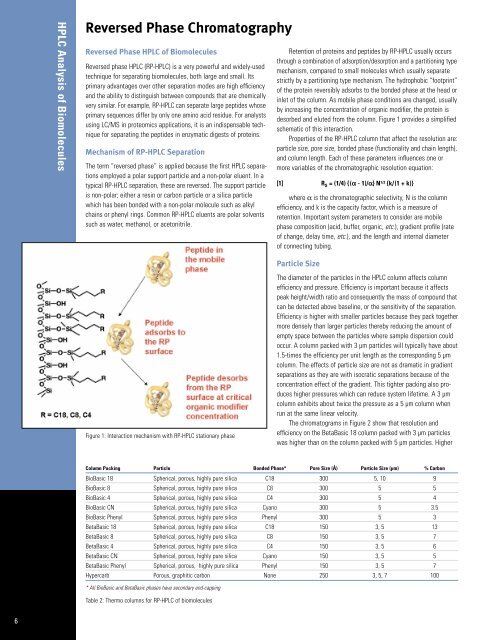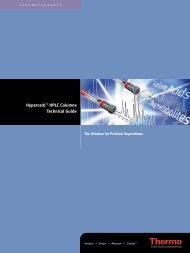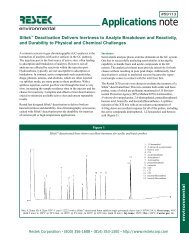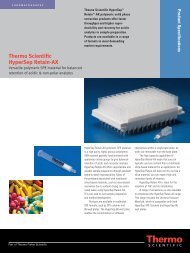HPLC Analysis of Biomolecules Technical Guide - Interscience
HPLC Analysis of Biomolecules Technical Guide - Interscience
HPLC Analysis of Biomolecules Technical Guide - Interscience
You also want an ePaper? Increase the reach of your titles
YUMPU automatically turns print PDFs into web optimized ePapers that Google loves.
6<br />
<strong>HPLC</strong> <strong>Analysis</strong> <strong>of</strong> <strong>Biomolecules</strong><br />
Reversed Phase Chromatography<br />
Reversed Phase <strong>HPLC</strong> <strong>of</strong> <strong>Biomolecules</strong><br />
Reversed phase <strong>HPLC</strong> (RP-<strong>HPLC</strong>) is a very powerful and widely-used<br />
technique for separating biomolecules, both large and small. Its<br />
primary advantages over other separation modes are high efficiency<br />
and the ability to distinguish between compounds that are chemically<br />
very similar. For example, RP-<strong>HPLC</strong> can separate large peptides whose<br />
primary sequences differ by only one amino acid residue. For analysts<br />
using LC/MS in proteomics applications, it is an indispensable technique<br />
for separating the peptides in enzymatic digests <strong>of</strong> proteins.<br />
Mechanism <strong>of</strong> RP-<strong>HPLC</strong> Separation<br />
The term “reversed phase” is applied because the first <strong>HPLC</strong> separations<br />
employed a polar support particle and a non-polar eluent. In a<br />
typical RP-<strong>HPLC</strong> separation, these are reversed. The support particle<br />
is non-polar; either a resin or carbon particle or a silica particle<br />
which has been bonded with a non-polar molecule such as alkyl<br />
chains or phenyl rings. Common RP-<strong>HPLC</strong> eluents are polar solvents<br />
such as water, methanol, or acetonitrile.<br />
Figure 1: Interaction mechanism with RP-<strong>HPLC</strong> stationary phase<br />
Retention <strong>of</strong> proteins and peptides by RP-<strong>HPLC</strong> usually occurs<br />
through a combination <strong>of</strong> adsorption/desorption and a partitioning type<br />
mechanism, compared to small molecules which usually separate<br />
strictly by a partitioning type mechanism. The hydrophobic “footprint”<br />
<strong>of</strong> the protein reversibly adsorbs to the bonded phase at the head or<br />
inlet <strong>of</strong> the column. As mobile phase conditions are changed, usually<br />
by increasing the concentration <strong>of</strong> organic modifier, the protein is<br />
desorbed and eluted from the column. Figure 1 provides a simplified<br />
schematic <strong>of</strong> this interaction.<br />
Properties <strong>of</strong> the RP-<strong>HPLC</strong> column that affect the resolution are:<br />
particle size, pore size, bonded phase (functionality and chain length),<br />
and column length. Each <strong>of</strong> these parameters influences one or<br />
more variables <strong>of</strong> the chromatographic resolution equation:<br />
[1] R S = (1/4) {(α - 1)/α} N 1/2 {k/(1 + k)}<br />
where α is the chromatographic selectivity, N is the column<br />
efficiency, and k is the capacity factor, which is a measure <strong>of</strong><br />
retention. Important system parameters to consider are mobile<br />
phase composition (acid, buffer, organic, etc.), gradient pr<strong>of</strong>ile (rate<br />
<strong>of</strong> change, delay time, etc.), and the length and internal diameter<br />
<strong>of</strong> connecting tubing.<br />
Particle Size<br />
The diameter <strong>of</strong> the particles in the <strong>HPLC</strong> column affects column<br />
efficiency and pressure. Efficiency is important because it affects<br />
peak height/width ratio and consequently the mass <strong>of</strong> compound that<br />
can be detected above baseline, or the sensitivity <strong>of</strong> the separation.<br />
Efficiency is higher with smaller particles because they pack together<br />
more densely than larger particles thereby reducing the amount <strong>of</strong><br />
empty space between the particles where sample dispersion could<br />
occur. A column packed with 3 µm particles will typically have about<br />
1.5-times the efficiency per unit length as the corresponding 5 µm<br />
column. The effects <strong>of</strong> particle size are not as dramatic in gradient<br />
separations as they are with isocratic separations because <strong>of</strong> the<br />
concentration effect <strong>of</strong> the gradient. This tighter packing also produces<br />
higher pressures which can reduce system lifetime. A 3 µm<br />
column exhibits about twice the pressure as a 5 µm column when<br />
run at the same linear velocity.<br />
The chromatograms in Figure 2 show that resolution and<br />
efficiency on the BetaBasic 18 column packed with 3 µm particles<br />
was higher than on the column packed with 5 µm particles. Higher<br />
Column Packing Particle Bonded Phase* Pore Size (Å) Particle Size (µm) % Carbon<br />
BioBasic 18 Spherical, porous, highly pure silica C18 300 5, 10 9<br />
BioBasic 8 Spherical, porous, highly pure silica C8 300 5 5<br />
BioBasic 4 Spherical, porous, highly pure silica C4 300 5 4<br />
BioBasic CN Spherical, porous, highly pure silica Cyano 300 5 3.5<br />
BioBasic Phenyl Spherical, porous, highly pure silica Phenyl 300 5 3<br />
BetaBasic 18 Spherical, porous, highly pure silica C18 150 3, 5 13<br />
BetaBasic 8 Spherical, porous, highly pure silica C8 150 3, 5 7<br />
BetaBasic 4 Spherical, porous, highly pure silica C4 150 3, 5 6<br />
BetaBasic CN Spherical, porous, highly pure silica Cyano 150 3, 5 5<br />
BetaBasic Phenyl Spherical, porous, highly pure silica Phenyl 150 3, 5 7<br />
Hypercarb Porous, graphitic carbon None 250 3, 5, 7 100<br />
* All BioBasic and BetaBasic phases have secondary end-capping<br />
Table 2: Thermo columns for RP-<strong>HPLC</strong> <strong>of</strong> biomolecules





